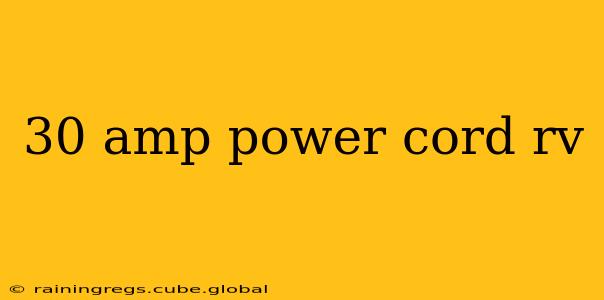Finding the right 30-amp power cord for your RV is crucial for safe and reliable power. A poorly chosen or maintained cord can lead to power outages, damage to your RV's electrical system, and even fire hazards. This guide will walk you through everything you need to know about selecting, using, and maintaining your 30-amp RV power cord.
What is a 30-Amp RV Power Cord?
A 30-amp RV power cord is a heavy-duty electrical cable designed to carry up to 30 amps of electricity from a power source (like an RV park's pedestal) to your RV. It's a vital component connecting your RV's electrical system to the external power grid, enabling you to run appliances and electronics while camping. The cord itself is typically composed of three wires: hot, neutral, and ground, encased in a durable, weather-resistant jacket.
How Long Should My 30-Amp RV Power Cord Be?
The ideal length of your 30-amp RV power cord depends entirely on your camping style and the typical locations you frequent. Consider the distance between your RV's power inlet and the campground's power pedestal. It’s best to err on the side of slightly longer than you think you'll need to allow for flexibility in positioning your RV. A cord that's too short can strain the connections and increase the risk of damage.
What are the different lengths available?
You'll find 30-amp RV power cords in various lengths, typically ranging from 20 feet to 50 feet or more. Longer cords offer greater flexibility, but they also increase resistance and can lead to voltage drops, especially in older or lower-gauge cords. Shorter cords offer better performance but limit placement options.
How to Choose the Right 30-Amp RV Power Cord
Several factors influence the choice of a 30-amp power cord. Pay attention to these key features:
-
Gauge: The gauge refers to the thickness of the wire. A lower gauge number (e.g., 10-gauge) signifies thicker wire, capable of carrying more current with less resistance and heat build-up. Thicker wires are safer and more reliable. Look for a 10-gauge cord as a minimum for a 30-amp service.
-
Material: The cord's outer jacket should be made of durable, weather-resistant material to withstand exposure to the elements. Look for materials like rubber or high-quality PVC.
-
Connectors: Ensure the connectors on both ends (the RV end and the pedestal end) are securely attached and are the correct type (NEMA 14-30). Check for any signs of damage or corrosion before purchasing.
-
Length: As mentioned above, choose a length that provides enough reach without being excessively long.
-
Brand Reputation: Opt for reputable brands with a history of producing high-quality RV power cords. Reading reviews from other RVers can help inform your decision.
Troubleshooting Your 30-Amp RV Power Cord
-
Power outage: If you experience a power outage, check the cord for any visible damage, loose connections, or tripped breakers both at the pedestal and inside your RV.
-
Overheating: Overheating is a serious sign of a problem. This could indicate a fault in the cord, a problem with your RV's electrical system, or an overloaded circuit.
-
Loose Connections: Regularly inspect the connections at both ends of the cord. Loose connections can cause overheating, sparks, and potential fire hazards.
Frequently Asked Questions (FAQ)
Can I use a 50-amp power cord with a 30-amp RV?
No, you should not use a 50-amp power cord with a 30-amp RV. While it might seem to fit (using an adapter), doing so can damage your RV's electrical system. Always use a power cord that matches the amperage rating of your RV's power inlet.
What is the difference between a 30-amp and a 50-amp RV power cord?
The key difference lies in their amperage capacity. A 50-amp cord can carry significantly more current, allowing you to run more appliances simultaneously. A 30-amp cord is suitable for smaller RVs and those with moderate power demands. The physical connectors are also different, preventing accidental mismatches.
How often should I inspect my 30-amp RV power cord?
Regular inspection is crucial for safety. Check your cord before each trip and whenever you suspect a problem. Look for any signs of damage, wear, fraying, or loose connections.
By understanding the nuances of choosing and maintaining your 30-amp RV power cord, you ensure the safety and reliability of your RV's electrical system and enjoy worry-free camping trips. Remember to always prioritize safety and never compromise on quality.
